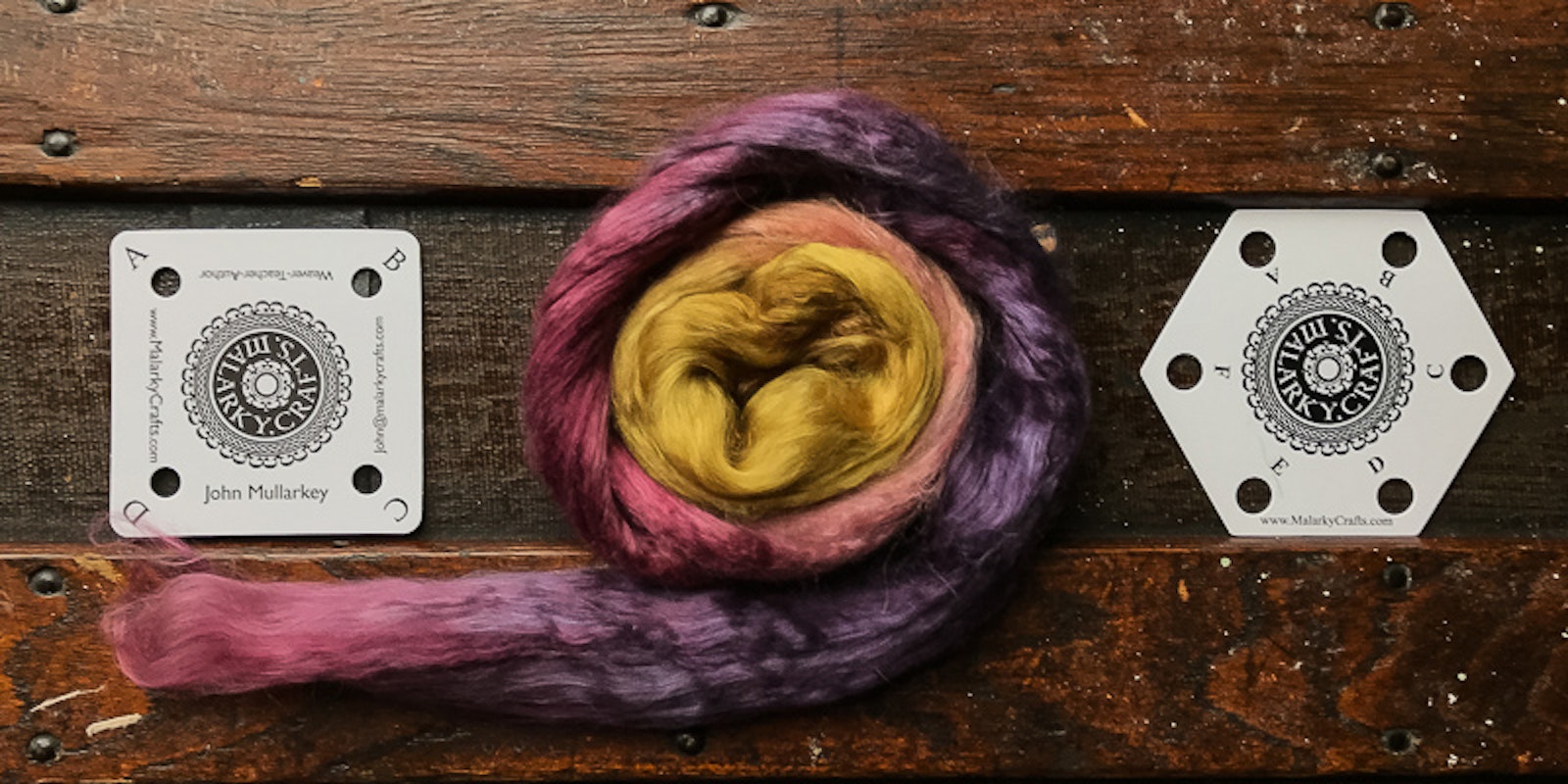Card weaving, also known as tablet weaving, is a band-weaving method that uses hole-punched cards or tablets to mimic a loom’s shafts or heddles. Renowned tablet-weaving instructor John Mullarkey says, “Even though it does not offer as much structural variety as a floor loom, card weaving has more pattern flexibility.”
We asked John for a few spinning tips for those of us delving deeper into spinning for delicious bands.
 Weaving well: John teaches workshops around the United States and abroad; photo by Kate Larson (left). John will be teaching Two-Sided Tablet Designs at the Weave Together with Handwoven weaving retreat next February; photo courtesy of Handwoven magazine (right).
Weaving well: John teaches workshops around the United States and abroad; photo by Kate Larson (left). John will be teaching Two-Sided Tablet Designs at the Weave Together with Handwoven weaving retreat next February; photo courtesy of Handwoven magazine (right).
What are your favorite fibers to spin for tablet weaving?
I LOVE spinning silk and using it in my bands. I’ve spun wool and used it for card weaving, but it is harder to weave than silk and not nearly as luscious. As a result, I avoid short-stapled fibers for card weaving—especially cotton.
 Boneyard Boogie, handspun and woven by John Mullarkey. “This project is a perfect example of why one would spin their own yarn for card weaving,” John says. “The depth of color in the night sky can only be achieved by spinning the handpainted fiber. If I had spun white silk and dyed it after, I never would have gotten the rich colors I got by spinning the dyed fibers.” Photo by Kate Larson
Boneyard Boogie, handspun and woven by John Mullarkey. “This project is a perfect example of why one would spin their own yarn for card weaving,” John says. “The depth of color in the night sky can only be achieved by spinning the handpainted fiber. If I had spun white silk and dyed it after, I never would have gotten the rich colors I got by spinning the dyed fibers.” Photo by Kate Larson
How much twist do you add to your tablet-weaving yarns?
Because card weaving actually changes the nature of the underlying yarn (adds twist or removes twist depending on the direction the cards are turning), I put lots of twist in my silk both the singles and the plying. I almost always use two-ply yarns.
What is your best piece of advice for spinning for card weaving?
Again, lots of twist! And the smoother the yarn, the better. I love spinning and weaving bombyx silk, but I don’t like tussah. Even when spun with a worsted draw with lots of twist, tussah silk tends to be fuzzier and doesn’t spin nearly as smooth, which is important for card weaving.
Have you ever planned and spun the yarn for a band that didn’t work well? What happened?
Oh, yes. I had a band that was two colors: gold and purple. I thought the purple was dark and the gold was light, so I wove it all up and there wasn’t enough contrast. The gold was too dark and the purple was lighter than expected. Hence you couldn’t see the pattern at all. My lesson learned was to always check value and don’t just assume a color is light or dark because of hue.
 John's beautiful—but low contrast—band; photo courtesy of John Mullarkey (left). By comparison, contrasting colors in the shoelace from John’s Woven Shoelaces class make the design pop; photo by Matt Graves (right).
John's beautiful—but low contrast—band; photo courtesy of John Mullarkey (left). By comparison, contrasting colors in the shoelace from John’s Woven Shoelaces class make the design pop; photo by Matt Graves (right).
John teaches tablet-weaving workshops for raw beginners, intermediate weavers looking to learn more, and advanced students continuing to expand their band repertoire. You can find him at various workshops throughout the year.
Plus, join John at Weave Together with Handwoven, an all-inclusive weaving retreat in Colorado in February 2024, where he’ll be teaching a variety of courses that include Woven Shoelaces, Two-Sided Tablet Designs, and Coptic Diamonds. Join us for four luxurious days of weaving with John and other world-class instructors and courses that fit your interests. Find out more on the Weave Together website.
Kate Larson, editor of Spin Off, teaches handspinning around the country and spends as many hours as life allows in the barn with her beloved flock of Border Leicesters.
Originally published March 15, 2018. Updated January 23, 2019. Updated October 4, 2023.

